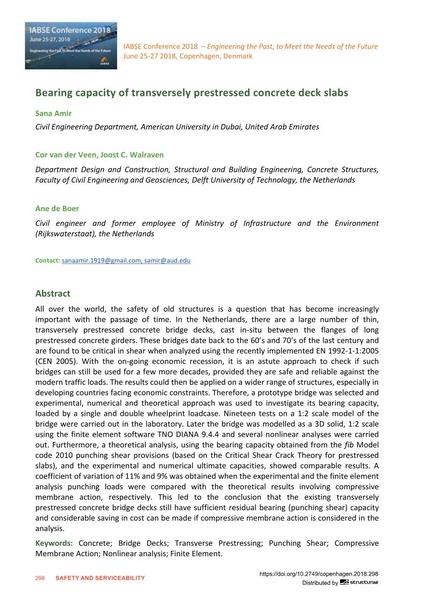Bearing capacity of transversely prestressed concrete deck slabs

|
|
|||||||||||
Bibliographic Details
| Author(s): |
Sana Amir
(Civil Engineering Department, American University in Dubai, United Arab Emirates)
Cor van der Veen (Department Design and Construction, Structural and Building Engineering, Concrete Structures, Faculty of Civil Engineering and Geosciences, Delft University of Technology, the Netherlands) Joost C. Walraven (Department Design and Construction, Structural and Building Engineering, Concrete Structures, Faculty of Civil Engineering and Geosciences, Delft University of Technology, the Netherlands) Ane de Boer (Civil engineer and former employee of Ministry of Infrastructure and the Environment (Rijkswaterstaat), the Netherlands) |
||||
|---|---|---|---|---|---|
| Medium: | conference paper | ||||
| Language(s): | English | ||||
| Conference: | IABSE Conference: Engineering the Past, to Meet the Needs of the Future, Copenhagen, Denmark, 25-27 June 2018 | ||||
| Published in: | IABSE Conference Copenhagen 2018 | ||||
|
|||||
| Page(s): | 298-305 | ||||
| Total no. of pages: | 8 | ||||
| DOI: | 10.2749/copenhagen.2018.298 | ||||
| Abstract: | All over the world, the safety of old structures is a question that has become increasingly important with the passage of time. In the Netherlands, there are a large number of thin, transversely prestressed concrete bridge decks, cast in-situ between the flanges of long prestressed concrete girders. These bridges date back to the 60’s and 70’s of the last century and are found to be critical in shear when analyzed using the recently implemented EN 1992-1-1:2005 (CEN 2005). With the on-going economic recession, it is an astute approach to check if such bridges can still be used for a few more decades, provided they are safe and reliable against the modern traffic loads. The results could then be applied on a wider range of structures, especially in developing countries facing economic constraints. Therefore, a prototype bridge was selected and experimental, numerical and theoretical approach was used to investigate its bearing capacity, loaded by a single and double wheelprint loadcase. Nineteen tests on a 1:2 scale model of the bridge were carried out in the laboratory. Later the bridge was modelled as a 3D solid, 1:2 scale using the finite element software TNO DIANA 9.4.4 and several nonlinear analyses were carried out. Furthermore, a theoretical analysis, using the bearing capacity obtained from the fib Model code 2010 punching shear provisions (based on the Critical Shear Crack Theory for prestressed slabs), and the experimental and numerical ultimate capacities, showed comparable results. A coefficient of variation of 11% and 9% was obtained when the experimental and the finite element analysis punching loads were compared with the theoretical results involving compressive membrane action, respectively. This led to the conclusion that the existing transversely prestressed concrete bridge decks still have sufficient residual bearing (punching shear) capacity and considerable saving in cost can be made if compressive membrane action is considered in the analysis. | ||||
| Keywords: |
concrete non-linear analysis finite element FE punching shear Bridge Decks transverse prestressing Compressive
Membrane Action
|
||||
